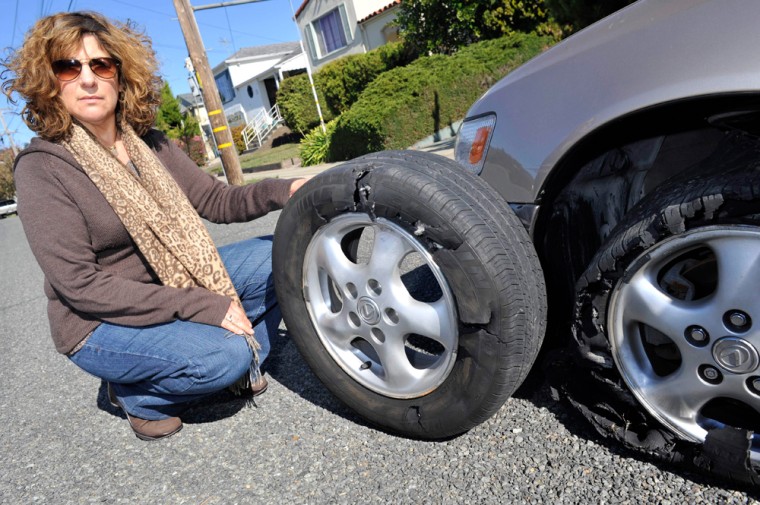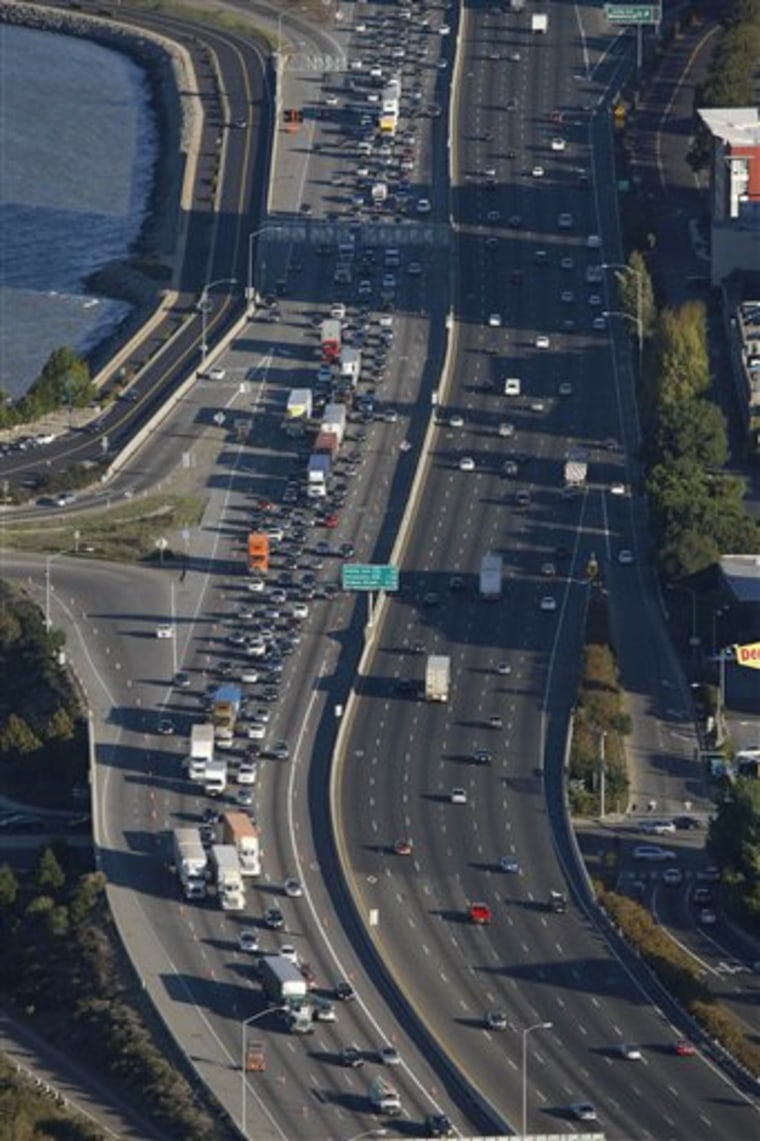When 5,000 pounds of metal broke off the San Francisco-Oakland Bay Bridge and rained down on traffic during rush hour, the accident resurrected fears about the safety of a span that millions watching the 1989 World Series broadcast learned had failed during an earthquake.
The terrifying scene on Tuesday left only one motorist with minor injuries, but stirred anger over the constant delays and soaring costs of the still-unfinished new eastern span of the Bay Bridge, which has become the most expensive public works project in California history.
"I thought I was going into the Bay," said Andrea Nelson, a marketing consultant and personal coach who saw the crossbar and two rods fall and bounce on the road ahead of her as she headed into San Francisco for dinner. She swerved and her car spun out as she ran over the rods, which gashed her tires.
"I have lost so much confidence in the experts, the millions of dollars that are being spent to reconstruct and build a new bridge," she said. "I just find it shocking and unacceptable."
The catalyst for a replacement span was the 1989 Loma Prieta earthquake, which caused a 50-foot section of the bridge's upper deck to collapse onto the deck below, causing another section to give way. It took state officials until 1997 to decide it would be cheaper over the long run to build a new span than retrofit the existing one.
Cost to replace: $7.2 billion
The cost initially put forth for replacing the bridge was $1.3 billion with a 2004 completion; that has grown to $7.2 billion with a 2013 opening. Meantime, the existing eastern span was outfitted with giant shock absorbers and other fortifications meant to help it withstand a quake.
Officials provided no precise estimate of when traffic would reopen on one of the region's major transportation arteries. But Bart Ney, a spokesman for the California Department of Transportation, said it might be as soon as Thursday.
Construction crews worked through Tuesday night fighting winds that gusted to 35 mph as they brought in heavy machinery to try to move the metal and make repairs. On Wednesday, the strong winds continued to hamper efforts to repair the bridge that carries about 280,000 cars each day.
"We have several thousand pounds of steel we have to place hundreds of feet off the deck, so worker safety is a concern," said Ney.
The pieces that failed were parts of major repairs done last month after state inspectors discovered a crack in an "eyebar," an important structural beam. The rods that broke were holding a saddle-like cap that had been installed to strengthen the cracked eyebar.
Caltrans engineers were trying to figure out why the recent repairs — which were supposed to last until the new bridge opened in 2013 — failed in less than two months.
Ney said the strong winds likely played a role in the failure, which heightened concerns by some experts about the integrity of the repair and the bridge's safety in an earthquake. Scientists in 2008 said there is a 63 percent probability of a quake similar to the 6.9-magnitude Loma Prieta temblor in the Bay area over the next 30 years.
Repair described as a ‘Band-Aid’
Abolhassan Astaneh-Asl, a civil engineering professor at the University of California, Berkeley who studied the effects of the 1989 earthquake on the bridge, called the repair last month a "Band-Aid" that jeopardized public safety to get the bridge open quickly.
"When this eyebar fractured, this is very serious element of this part of the bridge. So the safety issue is very serious here," he said. "The repair done, in my opinion, is very unusual to put it mildly."

The main contractor on the repairs, C.C. Meyers, Inc., stood by the work, but deferred to Caltrans to determine why the pieces failed, spokeswoman Beth Ruyak said.
Meanwhile, the Federal Highway Administration sent engineers on Wednesday to help Caltrans investigate. The federal agency said it had not inspected the Labor Day weekend repairs made to the heavily used span, instead relying on state inspection reports to ensure safety guidelines were met.
"We're on our way to find out what happened with the repair," said Nancy Singer, a spokeswoman for the highway administration.
Traffic was jammed on other San Francisco-area highways, as commuters looked for alternatives to the bridge.
At a Bay Area Rapid Transit station in downtown San Francisco commuter crowds usually thin out by 9 a.m. But Wednesday, it was 11 a.m. and still looked like the end of rush hour.
The information kiosk at the station had a line of people waiting to ask questions that regular BART riders already know.
Kyla Monaghan, a graphic artist who lives in Oakland, waited until 10:30 to leave home Wednesday morning to try and miss the expected increase of riders on her usual 8:30 a.m. train.
"I didn't want to be squished on a train," she said. "Normally, I sit down, read my magazine. Getting to work is usually the least stressful part of it."
More on:
